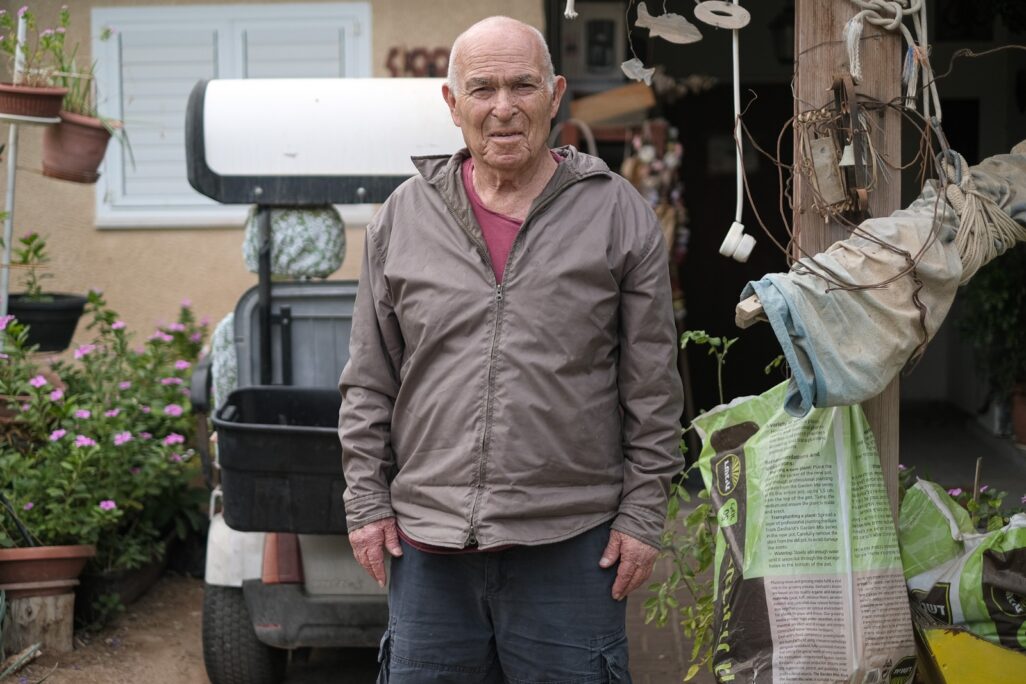
Dubi Helman, the former secretary-general of the kibbutz movement and to this day one of its prominent leaders, believes that the last three months have proven the movement’s relevance to the State of Israel. "These are people who for decades did not abandon their homes," he said in an interview with 'Davar.' "They were shot at and some were killed – and yet they continued to grow and expand the economy and the community."
Helman, a member of Kibbutz Yotvata for 50 years, rejects outright the frequent criticism of the kibbutz movement's obsolescence to modern Israeli life, and claims that on the day of the disaster, the movement’s core values were the reason for its resilience. "The uniqueness of the kibbutz, and its national mission, is hityashvut," he says, referring to the concept of establishing autonomous Jewish communities in the land of Israel. "In this respect, there is no difference between the privatized Kfar Azza and the cooperative Kibbutz Be’eri, [two of the Gaza border communities that were most heavily devastated on October 7]. In the moments of crisis, they functioned in the same way. All the privatized kibbutzim, which are now called 'renewed kibbutzim,' continue to lead a kind of communal and cultural life. This style of organization was reflected in how the kibbutzim reacted to the disaster, and can also be seen in their recovery and rehabilitation."
In the ongoing debate about the role of the kibbutz movement at a time when the values of equality and solidarity are seen as foolish fragments of more ideological times, Helman finds himself in the minority. But according to him, the values of the kibbutz still affect large parts of society. "Since the establishment of the State, a process began, which has only intensified over the years." Helman explains. "The perception was that the kibbutzim had completed their mission, and were no longer needed. It started as an outside perspective, and it slowly trickled in [to the kibbutz movement itself]."
Helman prefers to judge the kibbutzim according to the goals they set for themselves: hityashvut, agriculture, and defense. "[Cities like] Sderot, Ofakim, and Tel Aviv are also examples of hityashvut – but dense cities, in which 90% of Israelis live, cannot hold large swaths of land. Only a working settlement can do that. The kibbutzim were established to enable strong communities to meet this challenge.To establish true Jewish sovereignty over the land. The kibbutz is unique in the landscape thanks to its talent for establishing settlements. Hityashvut includes the labor, the factories, and the agriculture. It's the community, it's the organization – which we see very well right now, but was only made possible because it existed long before October 7.
"What are people talking about now? Israeli agriculture. About the renewal of settlement and defense. Suddenly their eyes were opened, and people saw that these were the people who not only stood exposed and paid a heavy price for it – but were there to fight."
According to Helman, the historical approach to security for the settlements was based on the idea of spatial defense – each kibbutz was considered a unit that knew how to defend itself, and all the settlements together constituted an aid network that would be able to stop an attack before the army arrived. "People trained, were equipped with weapons, a chain of command was organized, but in the first decades of the state, the system was completely dismantled, because they said the IDF could replace it. Its last vestige is the standby units and the scant security organization, which on the morning of October 7 was the only thing present to stop the Hamas onslaught. One of the conclusions of October 7 is that this system must be rebuilt, because it is impossible to rely exclusively on the army."
"Without this Partnership, Jewish Sovereignty Will Not Survive"
Helman’s conception of the role of the kibbutzim was well within the mainstream in the first few decades of Israel’s independence. The kibbutz was not seen as an island, but as part of a network: the kibbutz movement. The movement gave meaning to the mission-driven nature of the kibbutzim, and knew how to support its members in their day-to-day challenges as well as in their struggles with the newly formed state. Now, Helman is sure that the the historical role of the kibbutzim must be part of the post-October 7 renewal process: from the restoration of the infrastructure, support for the reconstruction of kibbutzim, rejuvenation of the community and even bearing the torch of the memory of the bereaved by building monuments, museums and spaces that will tell about the disaster for future generations.
"Returning is a very difficult thing, and it should be treated seriously. How do you celebrate holidays in a settlement where so many were murdered? How do you restore the habits of common life again? The process of returning is not only a philosophical process of understanding who we are now – it is first and foremost a practical one. The kibbutz movement has a responsibility to get the factories and agricultural facilities back up and running. They will have to fight for improved conditions in agriculture, regulation, and prices. The regional councils and branches [along the Gaza border] are used to these struggles, but they are in a very severe crisis and the power of a unified movement action is required. Additionally, the kibbutzim also have a responsibility to remember the meaning behind the movement. In the process of restoring what we’ve lost, we need to revitalize the connection between kibbutzim and the youth movements, as was the case 30 years ago."
Helman is concerned by the common outlook among Israeli citizens that civil society, which has taken responsibility for Israel’s revitalization since October 7, will replace the responsibility of the state – and within it the kibbutzim. According to him, it is no coincidence that kibbutzniks had a high presence in the protest movement against the government’s attempted legal reforms last year. "People say that talking about a movement is archaic, but whoever thinks that way is archaic. Without the resilience, initiative and organizational abilities of the kibbutzim on October 7th – the situation would have been much worse.
"In the end, these are people who for decades did not abandon their homes. They were shot at and some were killed – and yet they continued to grow and expand the economy and the community. Such a life requires talent, experience, and a years-long financial commitment to the collective economy. There is room for criticism of the kibbutzim, even if the hostility towards them is often fueled from above, but without the partnership between cities and settlements, Jewish sovereignty will not be able to survive."
This article was translated from Hebrew by Etz Greenfeld.






